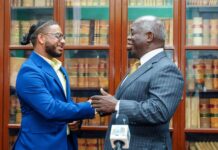The Ministry of Labour and Social Development Department of Social Services Disability Affairs Division’s Consultant Iris Adderley explains why filling out the National Registry Questionnaires for Persons with Disabilities (PWDs) is so important.
Nassau, Bahamas – Over the past two years, National Registry Questionnaires for Persons with Disabilities (PWDs) have been distributed across the country, with close to 2,000 having been returned to the Department of Social Services Disability Affairs Division thus far.
Consultant to the Division Iris Adderley, emphasising the need for more of the questionnaires to be turned in, explained that there are good reasons for the country to have reliable disability statistics; such as the need for these statistics when requests are made for funding from international agencies for programmes to help PWDs.
“In order for us to figure out a way to get these numbers, we at the Division realised we could not wait for the census, because the next census is in 2010,” Ms. Adderley said, pointing out that worldwide, it is known that about 10 to 12 percent of a country’s population will have a disability.
When the initiative began, the Division distributed the forms to the Department of Social Services offices throughout the islands and to Non-Government Organisations that are disability related, but to get the forms out to more people, the Division also plans to distribute them to healthcare facilities, ministries and other locations.
Ms. Adderley said persons are reluctant to fill out the questionnaire because they have fears of being stereotyped or feel they may be subjected to prejudice. This also means, she said, that they might not want their names on the forms for fear of persons finding out that they have a disability.
But the Consultant explained that the questionnaires are extremely confidential.
The names, she noted, are needed to ensure persons who might have the same names are not mixed up, or if the Division wants to track down a person for a programme it thinks might fit his or her needs.
She also explained why various types of information are needed as persons fill out the questionnaire, indicating that the Division asks for age so its can see whether there are trends for certain disabilities within certain age groups.
It asks for gender because they want to know whether certain disabilities are more prevalent in males than females, and asks for marital status to see the percentage of disabled persons who are single, married or divorced.
Ms. Adderley explained that statistics worldwide show husbands usually leave their spouses if they become disabled, while in most cases women stay with their husbands if they become disabled. The Division wants to track whether this trend is the same for The Bahamas.
The Division also wants to be able to ascertain whether individuals were allowed to continue with their education if they became disabled, or at what level they were able to continue with their education if they were born with a disability.
Ms. Adderley said it important to find out whether respondents were employed if they became disabled later in life; or whether being disabled affected respondents’ ability to get a job even if they had an education, which would be discrimination.
“So we want to know then whether your job is permanent because sometimes what happens is when you become disabled you are medically boarded and they send you home to rot as we call it. They do not understand that your brain still works.”
The Division also wants to look at the occupations of persons with disabilities, their income levels, whether they are being paid the same as someone without a disability, and whether they were on National Insurance.
She said the last section of the questionnaire allows respondents to say whether they are receiving the social services they need. These may include a need for food, shelter and medical care.
Therefore, Ms. Adderley explained that it was important for persons to know the different types of disabilities, which are broken down according to the definition of PWDs found in the United Nations Convention on the Rights of Persons with Disabilities.
The definition states: “Persons with disabilities include those who have long-term physical, mental intellectual, or sensory impairments which interaction with various barriers may hinder their full effective participation in society on an equal basis”.








